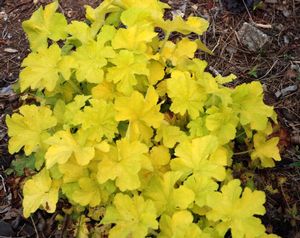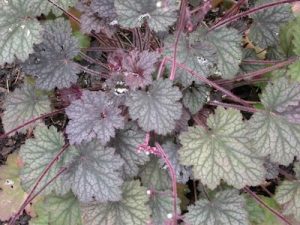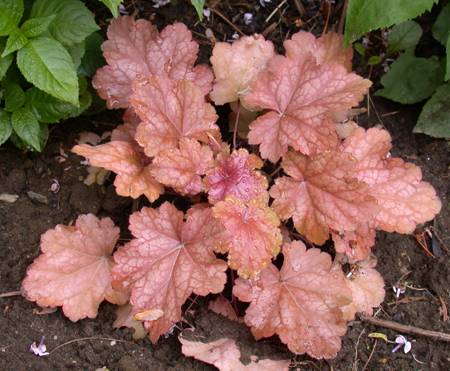Coral Bells
By Pat Dickey, Fairfax Master Gardener

Heuchera ‘Evergreen Forest’
Heuchera is a member of the Saxifragraceae family, named for plants with tiny flowers and suited for planting in rocky areas. It has been cultivated since the 16th century and was given its Latin name by Carl Linneas, the nomenclature botanist, in honor of Johann Heinrich Von Heucher, an 18th century German botanist and professor of medicine.
There are two native species of Heuchera from Virginia, Heuchera americana and Heuchera villosa, although there are 36 species throughout the United States, mainly in the West. H. americana has medium-sized palmately-lobed leaves with scalloped margins. H villosa has larger, “hairy”, angular leaves. In the early days, it was called Hairy Alumroot and its roots were used as an antiseptic and for other medicinal purposes.
Heuchera is a low maintenance, evergreen perennial that has multi-season interest. Its foliage emerges in the spring with its most dramatic and darker color, and a second flush of leaves appears in late summer that is more subdued. The foliage can grow from 6 in. to 18 in. tall. The air temperature must be mild for the Heuchera’s foliage to look its best. Freezing temperatures will cause the leaves to lie flat on the ground. There is also discoloration and burning of the leaves during harsh winters. You should remove any winter-damaged foliage in early spring. Add a thin layer of compost and a small amount of mulch around the plants to control any weeds.
In the Mid-Atlantic states, Heuchera cannot tolerate being planted in full sun. The foliage will not be attractive, growth will be stunted and the color will be different than expected. Space the plants 1 to 2 feet apart in well-drained average garden soil. Make sure plants receive 1 inch of water per week during the summer, including rainfall. The pink, coral, red or white floral inflorescences will reach 24 inches. Deadhead them after their blooms fade.
Heuchera can contract a few pests and diseases, but they can be prevented with proper care. Japanese beetles can be controlled by collecting them by hand. Also, plant Heuchera away from the lawn area where grubs will be. If you see leaf spots, remove any affected leaves; it is not life-threatening. Stem rot can be caused by overly wet soil and an overabundance of rainfall. Amend the soil when this is a problem to help with drainage. Heuchera will tolerate some dry soil but will not grow as large.

Citronelle

Bronze Wave
H. ‘Citronelle’ — electric-yellow fuzzy leaves; 14 in. high and 30 in. wide; blooms early July to mid-August; must receive shade all day long or foliage will fade
H. villosa ‘Bronze Wave’ — large, thick, glossy and angular leaves; 18 in. high and 38 in. wide; blooms late June to mid-August; up to 60 white inflorescences on each plant; easy care
H. Caramel — peach-colored large, fuzzy leaves in spring aging to a pale orangish yellow; 15 in. high and 30 in. wide; blooms mid-June to late August; shade needed for best coloring

Caramel
H. ‘Frosted Violet’ — purple with silver highlights; 14 in. high and 34 in. wide; blackish veins; leaves have a bluish-green cast in summer, a metallic sheen; bloom mid-June to late July; flowers fade from pink to white then green at different times, creating a confetti appearance
H. ‘Spellbound’ — ruffled foliage, silver with tints of rose purple; silver tones more in shade; 12 in. high and 30 in. wide; multi-crowned; pale yellow flowers; blooms early June to early August
 Frosted violet |
 Spellbound |
Resources
Heuchera for the Mid-Atlantic Region, Research Report, Mt. Cuba Center
Heuchera americana, North Carolina Extension Tool Box
Heuchera — Coral Bells, Clemson Cooperative Extension
. . . updated 2022